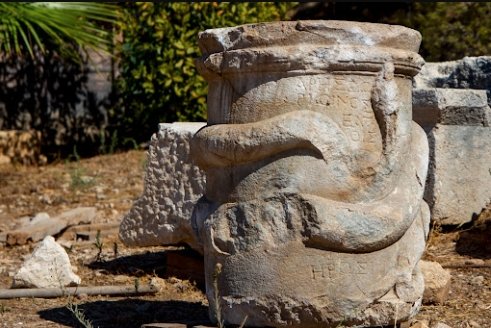Archaeologists have uncovered a remarkable 2,000-year-old snake altar in the ancient city of Patara, Türkiye. This unique find, featuring a coiled snake relief, offers new insights into the religious practices of ancient Greek civilizations. The altar, carved from marble, is believed to have been used for offerings to the gods of the underworld. This discovery not only highlights the rich cultural heritage of Patara but also provides a glimpse into the spiritual life of its ancient inhabitants.
The Discovery of the Snake Altar
The ancient city of Patara, located in Türkiye’s Antalya Province, has long been a site of archaeological interest. Known as the “cradle of civilizations,” Patara was a melting pot of cultures and a significant center of the Lycian League before becoming part of the Roman Empire. The recent discovery of the snake altar adds another layer to the city’s rich history.
The altar, adorned with a coiled snake relief and Greek inscriptions, was found during excavations led by Mustafa Koçak of Antalya Bilim University. The snake, a common symbol in ancient cultures, is believed to represent the gods of the underworld and agriculture. The altar’s pristine condition and intricate carvings suggest it played a vital role in the religious rituals of the time.

Archaeologists believe the altar was used for offerings of food and liquids to appease the gods. These offerings, which likely included bread and meat, were intended to ensure favorable conditions for agriculture and to honor the dead. The discovery of this altar provides valuable insights into the religious practices and beliefs of the ancient Greeks in Patara.
Significance of the Find
The snake altar is a significant addition to the archaeological record of Patara. It sheds light on the religious practices of the ancient Greeks and their relationship with the natural world. The use of snakes in religious iconography is not uncommon, but this particular altar is unique in its design and context.
The altar’s discovery highlights the importance of Patara as a religious and cultural center. The city’s strategic location and diverse population made it a hub of activity and innovation. The snake altar, with its detailed carvings and inscriptions, is a testament to the city’s rich cultural heritage and its role in the broader ancient world.
This find also underscores the importance of ongoing archaeological work in Patara. Each new discovery adds to our understanding of the city’s history and the lives of its inhabitants. The snake altar is a reminder of the complex and multifaceted nature of ancient Greek religion and its enduring legacy.
Future Research and Preservation
The discovery of the snake altar opens up new avenues for research and exploration. Archaeologists are eager to continue their work in Patara, hoping to uncover more artifacts and gain a deeper understanding of the city’s history. The altar’s unique design and inscriptions provide a wealth of information for scholars studying ancient Greek religion and culture.
Future research will focus on the altar’s inscriptions and their significance. By deciphering these texts, archaeologists hope to learn more about the rituals and beliefs associated with the altar. This information will contribute to a broader understanding of ancient Greek religious practices and their evolution over time.
Preservation efforts are also underway to ensure the altar remains in good condition for future study. The delicate nature of the marble and the intricate carvings require careful handling and conservation. By preserving this artifact, archaeologists can continue to learn from it and share its significance with the public.















